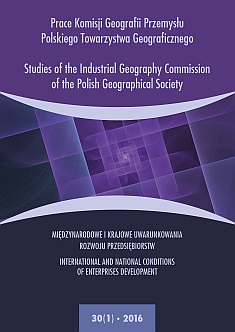The Role of Business in Local and Regional Development
DOI:
https://doi.org/10.24917/20801653.301.5Keywords:
enterprise, growth pole, local development, regional developmentAbstract
Describing the spatial aspects of economic growth requires knowledge of phenomena occurring in economy space, its course, effects and causes. Therefore, the purpose of this article is to explain in line with the theories of the local and regional development, the regularity of economic growth in terms of spatial aspects and to identify the mechanisms that shape their creation and diffusion of economic growth. Literature studies are the basic research method for the analysis presented in the paper. Conclusion from the analysis are as follow. The entrepreneurial activity is a prerequisite for creating a sustainable growth on the base of spatial systems set up by enterprises. In the short term the companies influence the economic growth at the local level, which in the long term is spread among the regional space as a result of linkages created with companies outside the local area.
Downloads
Metrics
References
Amin, A., Robins, K. (1990). Industrial disticts and regional development: limits and possibilities. W: F. Pyke i in. (red.). Industrial districts and inter-firm co-operation in Italy, 185–219.
Blažek, J., Uhlíř, D. (2011). Teorie regionálního rozvoje: nástin, kritika, klasifikace. Praha: Karolinum. Univerzita Karlova v Praze.
Brusco, S. (1986). Small firms and industrial districts: the experience of Italy. W: D. Keeble, E. Wever (red.). New firms and regional development in Europe, 184–202.
Chmiel, J. (1997). Małe i średnie przedsiębiorstwa a rozwój regionów. Prace Zakładu Badań Statystyczno-Ekonomicznych GUS i PAN, 243.
Cooke, P. (1992). Regional innovation systems: Competitive regulation in the new Europe. Geoforum, 3(23), 365–382.
Domański, B. (2008). Mechanizmy terytorialne różnicowania inwestycji kapitałowych. Kraków: Wydawnictwo Uniwersytetu Jagiellońskiego.
Etzkowitz, H. (2002). The Triple Helix of University – Industry – Government. Implications for Policy and Evaluation. Science Policy Institute Working Paper, 11.
Etzkowitz, H., Leydesdorf, L. (1997). Universities and the Global Knowledge Economy. A TripleHelix of University – Industry – Government Relations. London: Cassell Academic.
Friedmann, J. (1956). Locational aspects of economic development. Land Economics, 32, 213–227.
Frenken, K., Van Oort, F.G., Verburg, T. (2007). Related Variety, Unrelated Variety and Regional Economic Growth. Regional Studies, 5(41), 685–697.
Gancarczyk, J., Gancarczyk, M. (2002). Konkurencyjność skupisk przemysłu (clusters) – od korzyści zewnętrznych do korzyści sieci. Studia Regionalne i Lokalne, 2–3, 75–90.
Godlewska-Majkowska, H. (red.) (2005). Restrukturyzacja regionów przemysłowych. Warszawa: Oficyna Wydawnicza SGH.
Godlewska-Majkowska, H. (2009) (2016, 16 stycznia). Skuteczność specjalnych stref ekonomicznych jako instrumentu polityki regionalnej w Polsce. Pozyskano zhttp://www.paiz.gov.pl/files/?id_ plik=10631
Grosse, T.G. (2007). Wybrane koncepcje teoretyczne i doświadczenia praktyczne dotyczące rozwoju regionów peryferyjnych. Studia Regionalne i Lokalne, 1, 27–49.
Grzeszczak, J. (1999). Bieguny wzrostu a formy przestrzeni spolaryzowanej. Wrocław: Wydawnictwo Continuo.
Hansen, N. (1992). Competition, trust, and reciprocity in the development of innovative regional milieux. Papers in Regional Science, 71(2), 95–105.
Hirschman, A.O. (1958). The Strategy of Economic Development. New Haven: Yale Uniersity Press.
Kaja, J., Piech, K. (red.) (2005). Rozwój oraz polityka regionalna w Polsce. Warszawa: Oficyna Wydawnicza SGH.
Kuciński, K. (red.) (2010). Przedsiębiorczość a rozwój regionalny w Polsce. Wrocław: Diffin.
Krugman, P. (1991). Increasing Returns and Economic Geography. Journal of Political Economy, 99(3), 483–499.
Krugman, P., Venables, A.J. (1995). Globalization and the Inequality of Nations. Cambridge: National Bureau of Economic Research.
Malecki, E.J. (1991). Technology and Economic Development: The Dynamics of Local Regional and National Change Longman. London: Longman Pub Group.
Markusen, A. (1996). Stickyplaces in slip pery space: a typology of industrial districts. Economic Geography, 72(3), 293–313.
Matusiak, K.B. (2010). Budowa powiązań nauki z biznesem w gospodarce opartej na wiedzy. Rola i miejsce uniwersytetu w procesach innowacyjnych. Warszawa: Oficyna Wydawnicza SGH.
Molle, W., Cappellin, R. (1988). Regional impact of Community Policies in Europe. Aldershot: Avebury.
Myrdal, G. (1957). Economic Theory and Underdeveloped Regions. New York: Harper & Row.
Parr, J.B. (1999). Growth-pole Strategies in Regional Economic Planning: A Retrospective. Part 1. Origins and Advocacy. Urban Studies Journal Foundation, 36. DOI: 10.1080/0042098993187
Perroux, F. (1950). Economic Space, Theory and Applications. Quartely Journal of Economics, 64, 90–97.
Perroux, F. (1955). Note sur la notion de poles croissance. Economic Appliquee, 1–82, 307–320.
Porter, M.E. (1990). The Competitive Advantage of Nations. Harvard Business Review, March–April, 73–91.
Porter, M.E. (2001). Porter o konkurencji. Warszawa: PWE.
Romer, P. (1986). Increasingreturns and long-run growth. Journal of Political Economy, 94(5), 1002– 1037.
Runge, J. (2006). Metody badań w geografii społeczno-ekonomicznej – elementy metodologii, wybrane narzędzia badawcze. Katowice: Wydawnictwo Uniwersytetu Śląskiego.
Smith, D. (1966). A theoretical framework for geographical studies of industrial location. Economic Geography, 42, 95–113.
Stanny, M. (2013). Przestrzenne zróżnicowanie rozwoju obszarów wiejskich w Polsce. Warszawa: Instytut Rozwoju Wsi i Rolnictwa PAN.
Sternberg, R. (1996). Regional growth theories and high-tech regions. International Journal of Urban and Regional Research, 20(3), 518–538.
Storper, M. (1995). The Resurgence of Regional Economics, Ten Years Later. The Region as a Nexus of Untraded Interdependencies. European Urban and Regional Studies, 2(3), 191–221.
Strzelecki, Z. (red.) (2008). Gospodarka regionalna i lokalna. Warszawa: Wydawnictwo Naukowe PWN.
Wieloński, A. (2005). Geografia przemysłu. Warszawa: Wydawnictwo Uniwersytetu Warszawskiego.
Wieloński, A. (2007). Teoretyczne podstawy lokalizacji działalności gospodarczej. Warszawa: Wydawnictwo Uniwersytetu Warszawskiego.
Wojnicka, E., Tarkowski, M., Klimczak, P. (2005). Przestrzenne i regionalne zróżnicowanie ośrodków wzrostu. Polaryzacja a wyrównywanie szans rozwojowych. Przesłanki dla kształtowania polityki regionalnej państwa. Ekspertyza dla Ministerstwa Gospodarki i Pracy. Gdynia–Rzeszów.
Zioło, Z. (2011). Funkcjonowanie przedsiębiorstwa w strukturze regionu – zarys modelu. Nierówności społeczne a wzrost gospodarczy. Uwarunkowania sprawnego działania w przedsiębiorstwie i regionie, 20, 26–46.
Downloads
Published
How to Cite
Issue
Section
License
Articles are published under the terms of the Creative Commons License (CC BY-ND 4.0; Attribution– NoDerivs).

